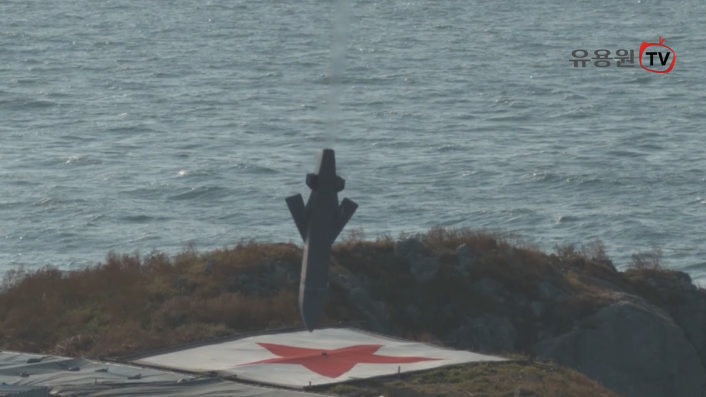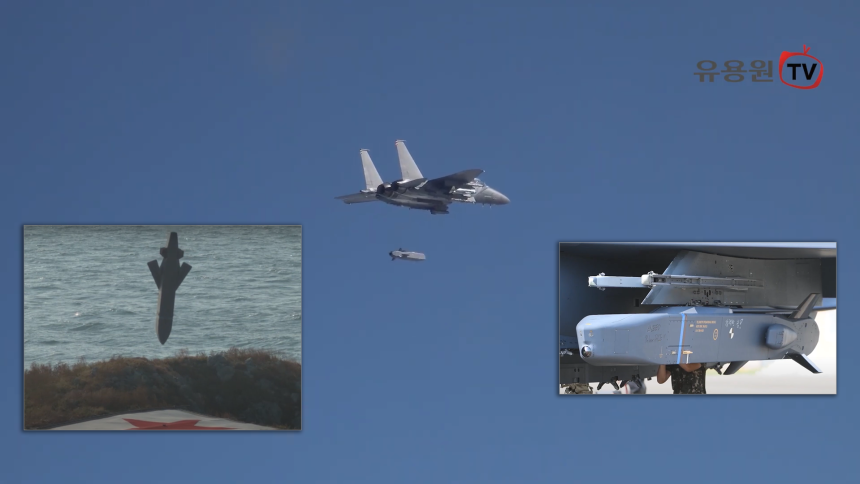The exercise shows the Republic of Korea Air Force F-15K Slam Eagle employing the Taurus KEPD to hit a target 400 km away, while F-35s, KF-16s and an E-737 were scrambled to simulate the interception of the weapon in a cruise missile defense scenario.
South Korean F-15K Slam Eagles live-fired the German-made Taurus KEPD 350K ALCM (Air-Launched Cruise Missile) on Oct. 8 and 10, 2024. The rare occurrence was part of a double purpose exercise where the weapon both struck a land target 400 km away and simulated a North Korean cruise missile for a cruise missile defense scenario.
The second part of the exercise involved the ROKAF’s (Republic of Korea Air Force’s) E-737 Peace Eye AEW&C (Airborne Early Warning and Control) aircraft, F-35As and KF-16 fighters which were scrambled to track and intercept the KEPD 350K in a “mock” shoot down after it was detected by the air defense.
These are rare exercises involving the ROKAF F-15K and the Taurus missile, as the two platforms have seldom figured in official publicity material. Earlier live-fire exercises with this weapon in the immediate past are not known. A video released by Yoo Yong-won TV shows the surface-strike component of the exercise, with the missile hitting the X-marked target in a near-vertical dive.
The video appears to show only the surface-strike exercise over the West Sea, with the hostile cruise missile simulation part that saw the F-35A, KF-16 and E-737s not immediately visible in the clip. Yoo Yong-won specified that the ROKAF used the inert variant of the weapon, as can be seen from the blue tape on the missile’s front section.
The Taurus missile was first deployed by ROKAF in 2016. The video description added that South Korea previously released footage from a live-fire employment of the KEPD 350 in 2017, in response to North Korea’s 6th nuclear test.
Photos of Taurus KEPD 350 air-launched cruise missiles being loaded onto a Republic of Korea AF F-15K Slam Eagle pic.twitter.com/QbxdBzT5VM
— Mike Yeo 杨启铭 (@TheBaseLeg) December 22, 2016
F-15K Slam Eagle and Taurus KEPD
The Slam Eagles are the mainstay of the ROKAF’s multirole missions, with a particular ‘heavy hitting’ long-range strike role. Their name is derived from their compatibility to operate the AGM-84 SLAM-ER standoff cruise missiles. The F-15K Slam Eagle can also carry the 2,131 kg (4,700 lb) GBU-28/B Paveway III LGB (Laser-Guided Bomb), also known as the ‘bunker buster’ Paveway.
The War Zone reported in Dec. 2022 that the Slam Eagles were poised for a massive uplift, comprising a new AESA (Active Electronically Scanned Array) radar, new mission computer, the latest cockpit displays, and possibly a new HMD (Helmet-Mounted Sight) replacing the current JHMCS. Specifically, according to some sources, the F-15K Performance Improvement Project, worth almost $ 3 billion, is expected to begin this year and will equip the country’s 59 F-15s with the APG-82 AESA radar, the ALQ-250 Eagle Passive Active Warning Survivability System (EPAWSS) and a large area display.
The KEPD 350 became another addition to its arsenal of devastating munitions in Nov. 2016, when Taurus Systems GmBH handed over the first lot of the missiles. The weapon’s guidance and navigation suite comprises a tri-mode INS-GPS-TRN (Inertial Navigation System-Global Positioning System-Terrain Reference Navigation), with the endgame dictated by an image referencing seeker.
The optical camera ball can be seen at the bottom of the trapezoidal-nose section. The KEPD 350 has top-mounted folding wings which deploy upon launch, X-shaped tail fins for stabilization and protruding side-intakes for its air-breathing engine.
With a range of 500 km at terrain hugging altitudes of only 35 meters, the Taurus KEPD 350 touches almost Mach 1 at 1,170 km/h (Mch 0.95). Its 481 kg, dual-staege MEPHISTO (Multi-Effect Penetrator High-Sophisticated and Target Optimized) warhead delivers primary and secondary charges for plowing through heavily fortified structures.
The F-15K/KEPD combination would be vital for hitting North Korea’s semi-strategic land targets, working together with the ROKAF’s F-35As and KF-16s. These targets include command and control centers, logistical supply nodes, battlefield headquarters located deep behind its lines in possibly underground bunkers or inside mountains.
The heavy-weight Slam Eagle can also carry a complement of air-to-air munitions for swing-role missions, with the AIM-120 AMRAAM and AIM-9 Sidewinder allowing it to conduct both beyond and within visual-range combat, respectively.
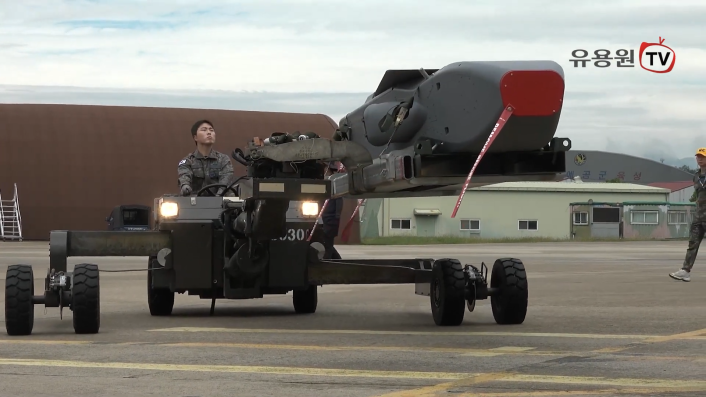
Video and exercise
A machine translation of the video description released by Yoo Yong-won suggests that the land-strike and the North Korean cruise missile simulation component were combined in the same individual mission, which was “conducted twice on the 8th the 10th.”
The video shows the ground crews loading the inert KEPD 350 missile on the Slam Eagle’s pylon under the left wing, with a Sniper targeting pod also visible under the left engine’s air intake. It’s interesting to note that the Sniper’s pylon also integrates an IRST (InfraRed Search and Track) sensor, known as ‘Tiger Eyes’ and developed from the AN/AAS-72.
The F-15 takes off followed by three other Slam Eagles, which are not carrying the KEPD 350, and subsequently releases the missile. An unspecified aircraft followed the missile in-flight, but we can assume it to be either an F-35A or, more probably, a KF-16. As mentioned before, the two types were tasked with tracking and simulating shooting down the KEPD 350 in coordination with the AEW&C aircraft and ground radars.
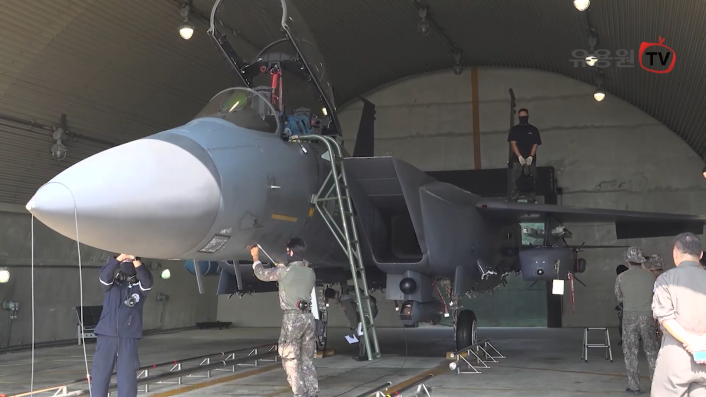
CCD and thermal camera footage of unspecified small islands in the West Sea show the missile striking a hillock. “The Taurus missile launched from an F-15K fighter jet flew approximately 400 km and accurately hit the target installed at the West Sea shooting range,” the statement said.
With the exercise, the ROKAF said it verified the KEPD’s operational capabilities, including the system integration, safe separation from the F-15K and “reaffirmed the powerful deterrence power of the Taurus missile against North Korea.” While the video shows the use of an inert missile, a massive outward explosion when the KEPD 350 struck the target. This could possibly be because of the engine and the internal fuel.
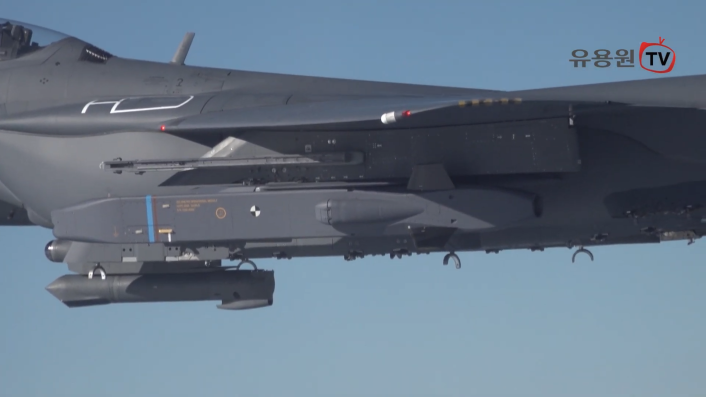
North Korean missile simulation
The exercise also trained ROKAF air defense crews to “master the response procedures for enemy cruise missiles,” said the video description. “The Taurus missile launched from the F-15K fighter jet simulated an enemy cruise missile flying at high speed at low altitude,” Yoo Yong-won wrote.
ROKAF first scrambled the E-737 AEW&C aircraft “upon identifying signs of an enemy cruise missile launch,” possibly after the F-15K released the missile. The E-737 “detected an unidentified target flying at high speed at low altitude over the West Sea,” and relayed the info to the F-35A and KF-16 fighter jets and the MCRC (Master Control and Reporting Center). The caption mentions the fighters were already in the air, perhaps on a routine CAP (Combat Air Patrol), before being retasked.
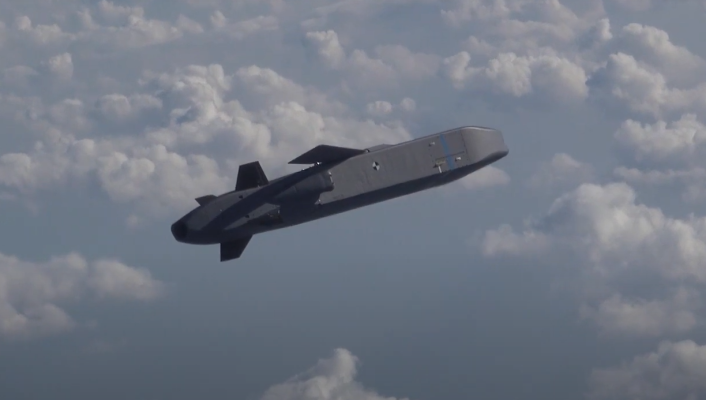
While the West Coast missile defense unit operating the Cheongung-II surface-to-air missiles tracked the missile route, F-35A and KF-16 fighter jets undertook visual identification “with the pilots’ eyes” and the “fighter jets’ PODs”, referring to both visual and sensor identification through the Sniper pods. The tactical action officer of the Korea Air and Space Operation Center (KAOC) then gave the go-ahead and the “F-35A successfully shot down the enemy cruise missile in a mock manner,” meaning the pilot simulated the engagement against the cruise missile with its on-board weapons.
The drill appears to be a simple exercise verifying an integrated air defense system that links and coordinates ground AD radars to airborne fighters and AEW&C aircraft. However, at the same time, it also shows that the ROKAF is ready to both repel a North Korean attack and strike deep behind enemy lines as tensions between the two neighboring countries keep arising.
